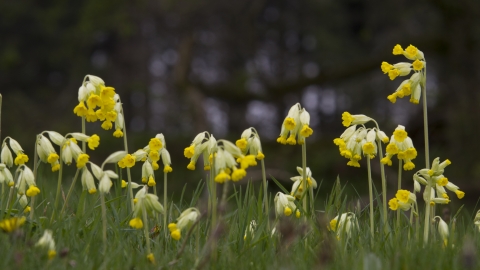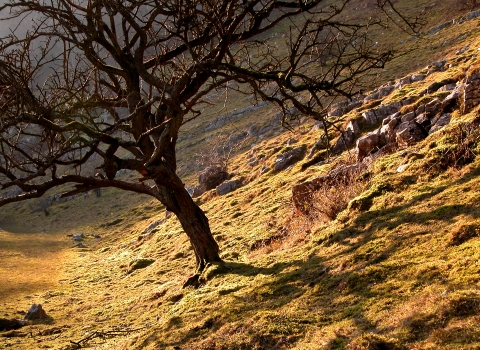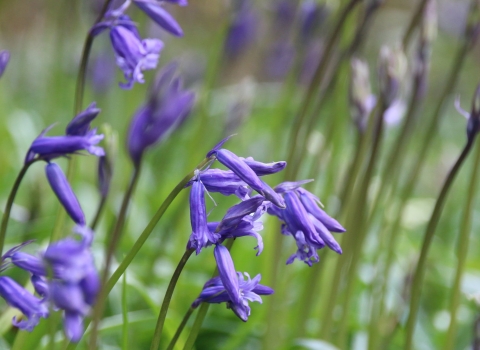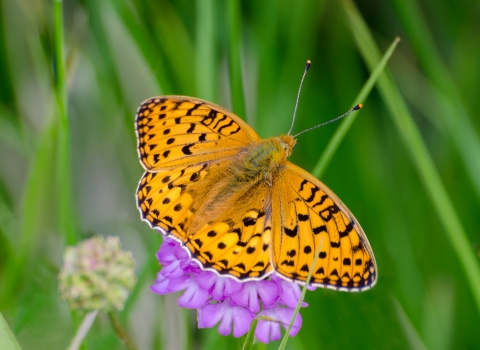
Cow Slip - Matthew Marshell
Location
Know before you go
Dogs
Visit the 'Dog walking on reserves' page in the Contact section for more information.
When to visit
Opening times
Open at all timesBest time to visit
April to JulyAbout the reserve
The reserve lies on the Cheddar Plateau and the rock forming the site is a hard, grey Carboniferous Limestone, which is exposed extensively across the reserve as rocky outcrops and low cliffs. The reserve is mostly grassland but with scattered trees and scrub.
Unimproved calcareous grassland occurs mainly in the northern and steeper half of the reserve but also in small patches amidst the semi-improved grassland lower down. Look out for Ladies Bedstraw, Wild Thyme, Common Bird’s-Foot Trefoil, Meadow Vetchling, Salad Burnet, Harebell, Cowslip, Quaking Grass, Small Scabious and Ploughman’s Spikenard. Much harder to spot are the small and very low growing Rue-Leaved Saxifrage, Early Hair-Grass, Field Madder, Parsley Piert and Fairy Flax. Early Purple, Common Spotted and Green-Winged orchids also occur.
Particularly in the northern and steeper part of the reserve Meadow Ant anthills are abundant and this is also the best place for butterflies including the Common Blue, Meadow Brown, Ringlet, Small Heath and the uncommon Wall Butterfly.
On the lower and more level areas of the site the major vegetation type is semi-improved neutral grassland with a less interesting flora. This is most likely because of fertilizer having been spread here in the past and which encourages grasses to grow vigorously and out compete the smaller flowering plants. The dominant grass species in these areas are Crested Dog’s-Tail, Common Bent and Yorkshire Fog. The very tiny Adder’s Tongue Fern also occurs in this grassland.
Despite appearing to be so inhospitable, a number of plants can be found growing on rock outcrops and stone walls around the reserve, including Wild Thyme, English Stonecrop, Biting Stonecrop, Woolly Thistle and Spring Sandwort . The ferns Brittle Bladder-Fern, Wall-Rue, Maidenhair Spleenwort and Scaly Male Fern also thrive in these rocky places.
Among the fungi recorded on the reserve are several species of waxcap including Hygrocybe Persistens, H. Coccinea and H. Punicea. All of these species are associated with unimproved grassland, the latter being a County Notable Species.
Of the three ponds within the site, one has had building rubble tipped into it in the past, before SWT acquired the land, and is mostly dry. The other two are dominated by Floating Sweet-Grass.
Skylark, Green Woodpecker, Song Thrush and Kestrel are resident through out the year. In Summer the trees and scrub on the reserve attract Whitethroats and Redstarts; Wheatears also regularly occur. Little Owls have also been seen, sheltering in the more mature trees and bushes. Large groups of Fieldfare can be seen on the reserve during the winter, feeding on Hawthorn berries.
Reserve conservation management - The fields are maintained by hay cutting on the meadows, combined with grazing by sheep, cattle and Exmoor ponies. This keeps the vegetation low to allow flowering plants to flourish. Scrub and Bracken are being controlled to prevent them from dominating the grassland.
History and Archaeology - The dry-stone walls found on the reserve are typical of the Mendips landscape and date back to the field enclosures of the 19th Century. The two groups of ruined buildings were probably once part of a farm. The shallow depressions still visible beside many of the structures suggest that stone for the walls and buildings was quarried on site as was customary on Mendips.
In some of the less flower-rich areas of the reserve the Trust have undertaken meadow restoration work to introduce a variety of plant species as part of the Coronation Meadows project, which aims to fulfill HRH Prince Charles’ vision to create new flower-rich meadows in every county. The ground was prepared by harrowing to create bare patches for seeds to germinate in, after which seed harvested from Somerset’s Coronation Meadow at our Chancellors Farm Reserve was spread by volunteers. By the following year, both Yellow Rattle and Eyebright had established, with more species expected to appear over time. Local school children also helped to grow and plant plugs of other key species such as Bird’s-Foot Trefoil, Common Knapweed and Cowslip.



